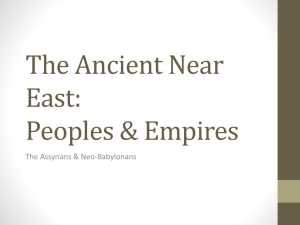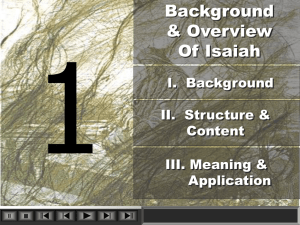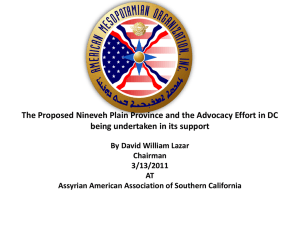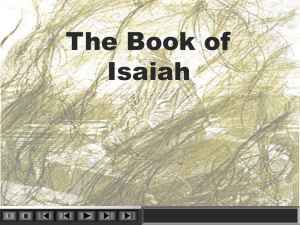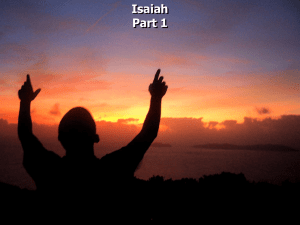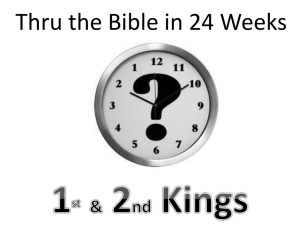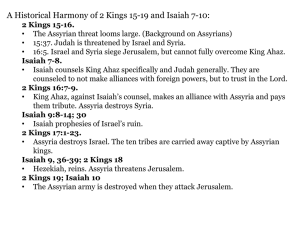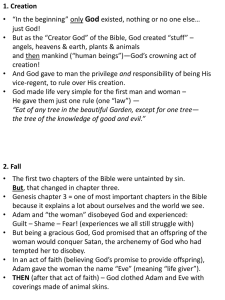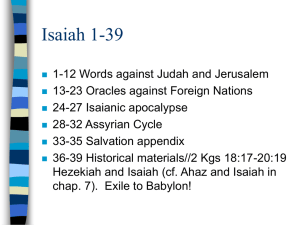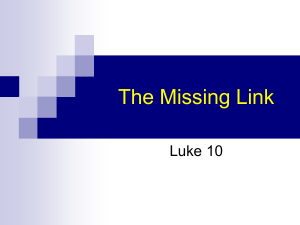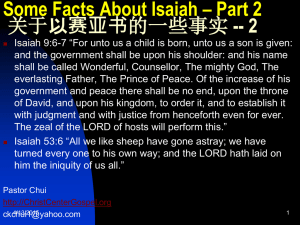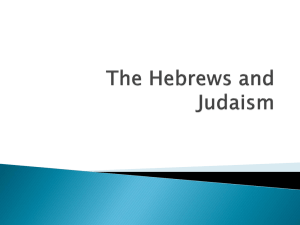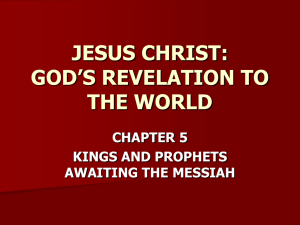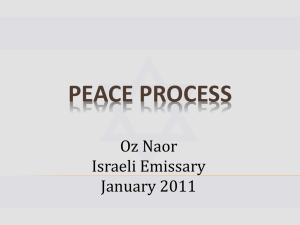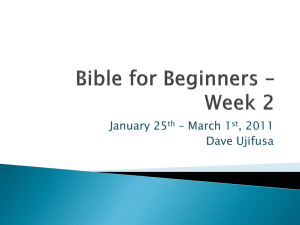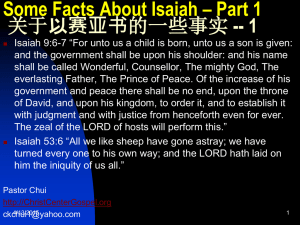The Book of Isaiah
advertisement
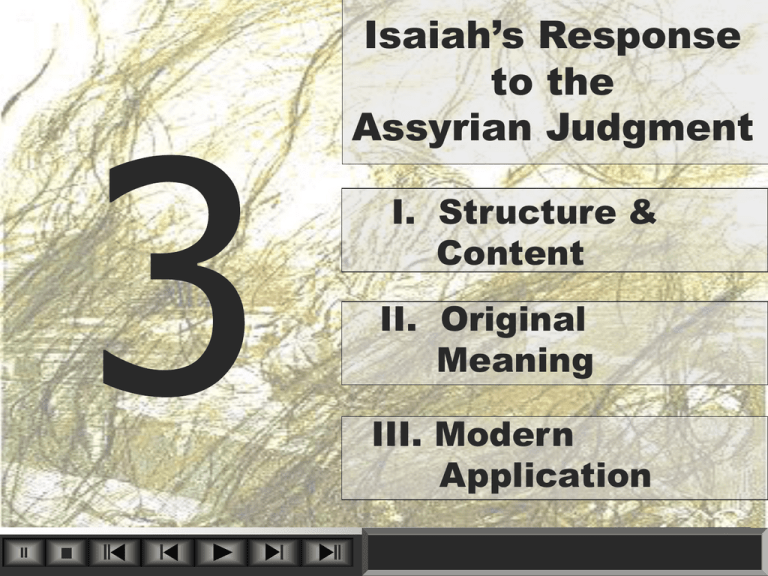
Isaiah’s Response to the Assyrian Judgment I. Structure & Content II. Original Meaning III. Modern Application 7:1-39:8 Response to the Assyrian Judgment A. The Syrian-Israelite Coalition (7:1—12:6) B. International Upheaval During the Assyrian Judgment (13:1—27:13) C. Sennacherib’s Invasion (28:1—39:8) International Upheaval During the Assyrian Judgment (13:1—27:13) 734 – 660 B.C. 734-722 B.C. 701-681 B.C.. The Syrian-Israelite Coalition (7:1—12:6) Sennacherib’s Invasion (28:1—39:8) Overview of Assyrian Judgment (3.1) A. The Syrian-Israelite Coalition (7:1—12:6) 1. The Assyrian Judgment and Isaiah’s Sons (7:1—8:18) (focus on the effects of events for Israel and Judah) 2. The Assyrian Judgment and Israel (8:19—10:4) (focus on the destruction of Samaria and exile) 3. The Assyrian Judgment and Judah (10:5—12:6) (focus on the destruction and deliverance of Judah) Assyrian Judgment and Isaiah’s Sons (7:1—8:22) Israel (7:4, 9; 8:4) Assyrian Judgment and Israel (9:1—10:4) (9:1, 9, 21) (8:14) Judah (7:9, 17; 8:8) Assyrian Judgment and Judah (10:5—12:6) (10:12, 24, 32; 12:6) Overview of 7:1-12:6 (3.2) The Assyrian Judgment and Isaiah’s Sons (7:1—8:18) Setting: 734 B.C. (7:1) Crisis in David’s House (7:1-2) The First Invasion (7:1) The Second Invasion (7:2) 2 Chr 28:5-6; 28:17-18, 23 Edom = Aram? ~ymiAda] ~r'a Isaiah’s First Commission and Son (7:3-25) Initial Command (7:3-4) Acknowledgment (7:5-6) Divine Assurance and Warning (7:7-9) Prediction of Sign (7:10-25) Offer of Sign (7:10-11) Ahaz’s Rejection (7:12) Judgment Oracle (7:13-25) Accusation (7:13) Sentencing (7:14-25) Initial Sentencing (7:14-17) First Elaboration (7:18-22) Second Elaboration (7:23-25) Plural Imperatives (Disciples) (8:12-15) Singular Imperative (Isaiah) (8:16) Isaiah’s Second Commission and Son (8:1-10) Commission (8:1-2) Birth of Son (Sign) (8:3-4) Judgment Oracle (8:5-8) Accusation (8:5-6) Sentencing (8:7-8) Assurance of a Call to War (8:9-10) (Defeat for Syria and Israel?) Isaiah’s Memoirs (8:11-18) Introduction (8:11) Call to for Disciples to Not to Panic (8:12) Assurance for Isaiah’s Disciples (8:13-15) Call to Keep Prophetic Testimony (8:16) Isaiah’s Commitment (8:17) Isaiah’s Summation of Signs (8:17-18) Structure/Content of 7:1-8:18 (3.3) The Assyrian Judgment and Isaiah’s Sons (7:1—8:18) Setting: 734 B.C. (7:1) OM I C C Crisis in David’s House (7:1-2) Isaiah’s First Commission and Son (7:3-25) Isaiah’s Second Comission and Son (8:1-18) Isaiah’s Memoirs (8:11-18) Meaning/Application of 7:1-8:18 (3.4) The Assyrian Judgment and Israel (8:19—10:4) [Part A] Setting: Before 722 Application to Future Judgment of Israel (8:19-22) Future Temptation (18:19-20a) Judgment against Apostates (18:20b-22) Future Royal Hope for Israel (9:1-7) Connecting Introduction (9:1) Description of Royal Blessings (9:2-7) Light and Joy for Israel (9:2-3) Explanation: Great Victory (9:4) Destruction of War Equipment (9:5) Explanation: Royal Son (9:6-7) Birth of King (9:6a) Titles of King (9:6b) Description of Reign (9:7) Plural Second Person (8:19) [disciples?] #[eAy al,P, rABGI lae d[;ybia] ~Alv'-rf; “wonder of a [military] advisor” (11:2; 36:5) “God is a warrior hero” (see Ps 45:6) “”Permanent Royal Father” “”prince establishing peace” Unending peace, permanent justice and righteousness, Guaranteed through the zeal of the Lord. Structure/Content of 8:19-9:7 (3.5) The Assyrian Judgment and Israel (8:19—10:4) [Part A] Setting: Before 722 OM I C C Application to Future Judgment of Israel (8:19-22) Future Royal Hope for Israel (9:1-7) Structure/Content of 8:19-9:7 (3.6) The Assyrian Judgment and Israel (8:19—10:4) [Part B] Setting: Before 722 Judgments of Israel Past and Future (9:8-10:4) Past Judgments (9:8-12) Accusation (9:9-10) Sentencing (9:11-12a) Refrain (9:12b) Past Judgments (9:13-17) Accusation (9:13) Sentencing (9:14-15) Accusation (9:16) Sentencing (9:17a) Refrain (9:17b) Further Judgments (9:18-21) Accusation (9:18) Sentencing (9:19-21a) Refrain (9:21b) Woe over Future Judgments (10:1-4) Accusations (10:1-2) Questioning (10:3) Sentencing (10:4a) Refrain (10:4b) Past: (9:12, 15) Future: (9:21; 10:3) Structure/Content of 8:19-10:4 (3.7) The Assyrian Judgment and Israel (8:19—10:4) [Part B] Setting: Before 722 OM I C C Past and Future Judgments (9:8-21) Woe over Future Judgments (10:1-4) Meaning/Application of 8:19-10:4 (3.8) The Assyrian Judgment and Judah (10:5—12:6) Setting: Between 722 B.C. and 701 B.C. (Samaria is fallen; Jerusalem is threatened. [10:9-11]) Woe to Assyria (10:5–19) Accusation: Assyria’s purpose is contrary to God’s purpose (10:5-11) Sentencing: When finished with Jerusalem, God will judge Assyria (10:12) Accusation: Assyrians said it was by their strength (10:13-14) Sentencing: God will judge Assyria “in a single day” (10:15-19) Judah’s Remnant “In that day”(10:20–34) Blessing and Judgment (10:20-23) Announcement of Judah’s Victory(10:24-26) Announcement of Assyrian’s Judgment (10:27-34) Initial Assurance (10:27) Assyrian Threat (10:28-31) Elaborated Assurance (10:32-34) Judah’s Hope in David’s Throne (11:1–16) A Shoot of Jesse (11:1) God’s Spirit on the King (11:2-3a) The King’s Rule (11:3b-9) The King and the Returning Remnant (11:10-16) Song of Praise in Zion (12:1–6) Call to Praise on “that day” (12:1-2) Assurance of Salvation (12:3) Call to Praise on “that day” (12:4-6) Contrasting Disputations: 10:8-11, 15 Theme of “that day” (10:20,27; 11:10,11;12:1,4) Messianic Armor: (11:5 cf Eph 6:14) “you” (plural) (12:1,3,4,6) Hezekiah vs. Eschatological Structure/Content of 10:5-12:6 (3.9) The Assyrian Judgment and Judah (10:5—12:6) Setting: 722 B.C. - 701 B.C. (Samaria is fallen; Jerusalem is threatened. [10:9-11]) OM I C C Woe to Assyria (10:5–19) Judah’s Remnant “In that day”(10:20–34) Judah’s Hope in David’s Throne (11:1–16) Song of Praise in Zion (12:1–6) Meaning/Application of 10:5-12:6 (3.10)
